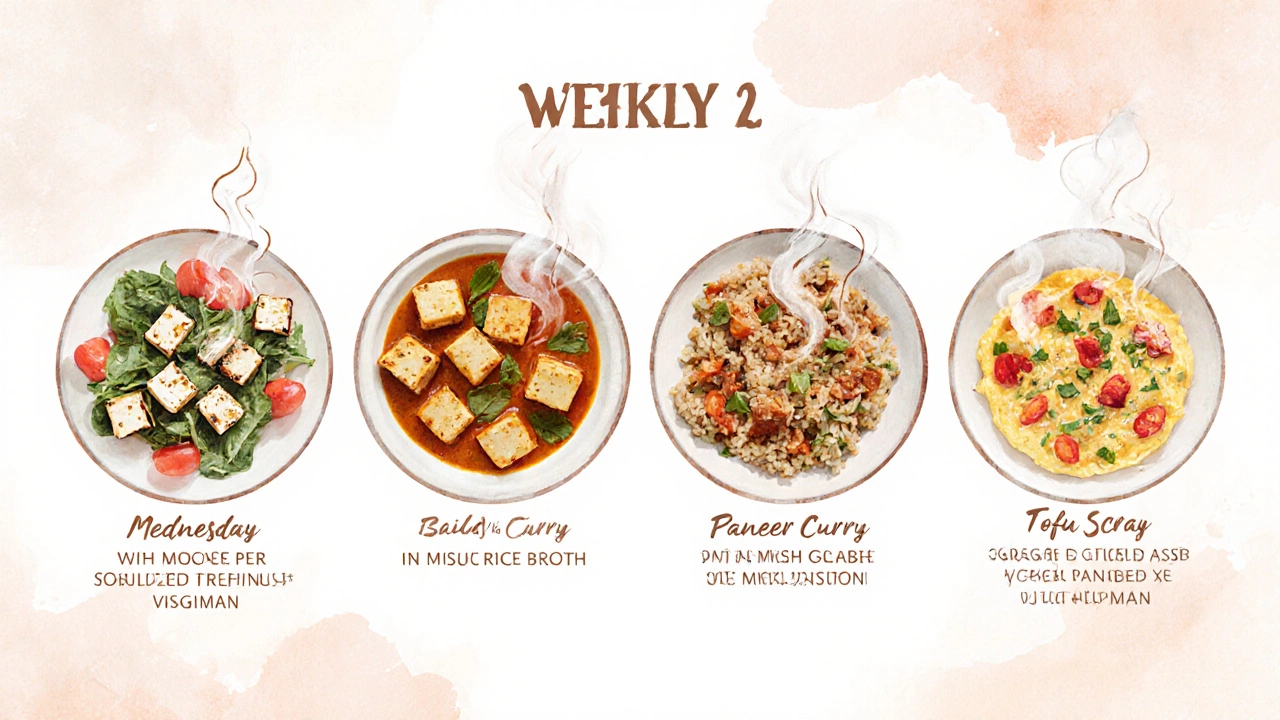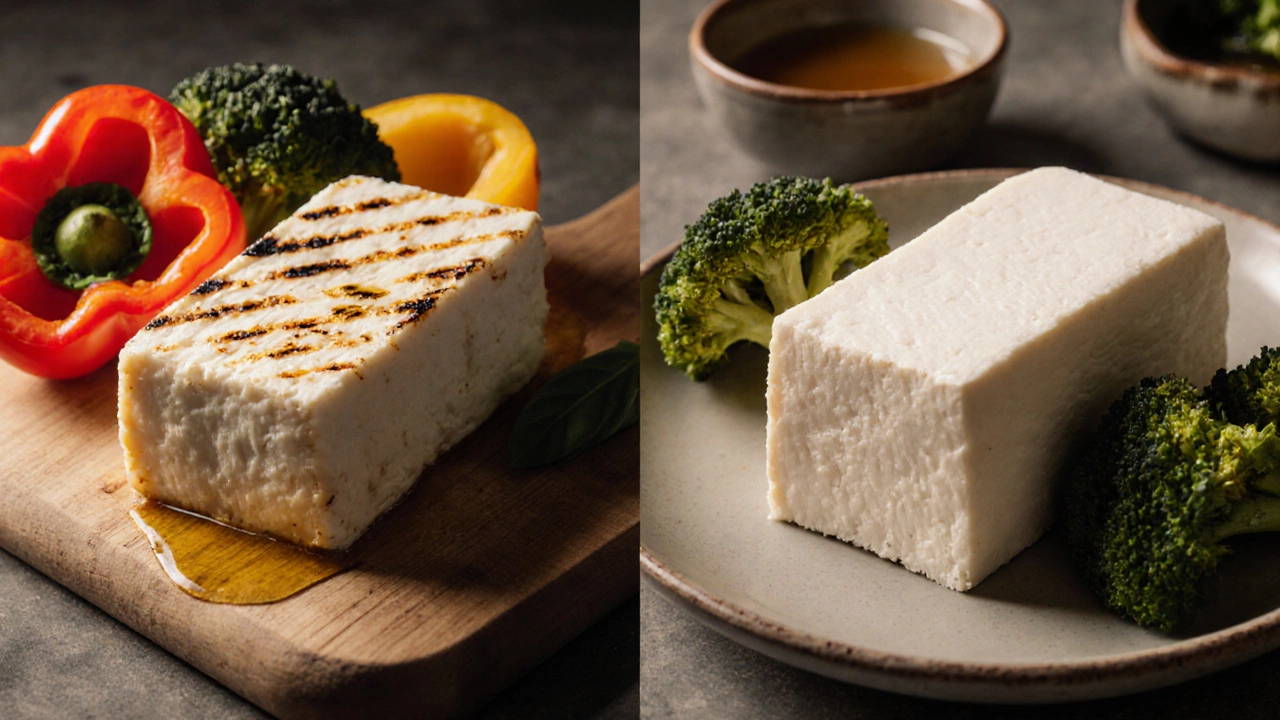15 Nov 2025
- 0 Comments
Protein & Calorie Calculator: Paneer vs Tofu
Compare Your Servings
When you're trying to lose weight, every bite counts. And if you're vegetarian or vegan, choosing the right protein source can feel like a tightrope walk between fullness and calories. Two staples often land in this debate: paneer and tofu. One comes from Indian kitchens, rich and creamy, made by curdling milk. The other is a soy-based block, common in Asian cuisines, light and soft. So which one actually helps you shed pounds better? Let’s cut through the noise and look at what’s really in each.
Paneer: The High-Protein Indian Cheese
Paneer is made by heating milk and adding an acid-lemon juice, vinegar, or yogurt-to separate the curds from the whey. The curds are then pressed into a firm block. It’s not aged like Western cheese, so it stays fresh and mild. A 100-gram serving of homemade paneer contains about 18 grams of protein and 265 calories. That’s a lot of protein for just a few bites. The fat content? Around 20 grams, mostly saturated. That’s not low, but it’s also not all bad. Saturated fat from whole dairy can help keep you full longer, which means fewer cravings later.
Paneer is also rich in calcium, phosphorus, and vitamin B12-all important for maintaining muscle mass while you’re losing fat. If you’re cutting calories but still want to hold onto lean tissue, that matters. A study from the Journal of Nutrition found that people who ate higher-protein dairy foods during weight loss lost more fat and kept more muscle than those on low-protein diets. Paneer fits that profile.
Tofu: The Light, Soy-Based Alternative
Tofu is made by coagulating soy milk and pressing the curds into blocks. It’s naturally low in fat and calories. A 100-gram serving of firm tofu has about 8 grams of protein and only 70 calories. That’s less than half the calories of paneer. The fat? Around 4 grams, mostly unsaturated-good for heart health. Tofu also contains isoflavones, plant compounds that may help regulate hormones and reduce inflammation.
But here’s the catch: tofu’s protein is incomplete. It has all nine essential amino acids, but in lower amounts than animal proteins. That doesn’t make it useless-it just means you need more of it to match paneer’s protein punch. If you’re eating tofu for weight loss, you’ll need larger portions to feel satisfied. And many people don’t like the bland taste. That’s why tofu often gets drowned in sauces, oils, or fried. Suddenly, those 70 calories become 250.
Calories vs. Satiety: What Really Matters
Weight loss isn’t just about counting calories. It’s about staying full so you don’t binge later. That’s where satiety scores come in. Paneer scores higher on the satiety index than tofu. Why? Protein and fat both slow digestion. When you eat paneer, your stomach stays full longer. Tofu digests faster. You might feel hungry again in two hours.
Try this: Have 100 grams of paneer for breakfast. Now have 100 grams of tofu. Which one keeps you from snacking by noon? Most people report paneer wins. That’s not magic-it’s biology. The body burns more calories digesting protein than carbs or fat. That’s called the thermic effect of food. Paneer gives you more of it.

Real-Life Use: How People Actually Eat Them
Let’s be honest. Most people don’t eat plain paneer or tofu. They cook with them. And that changes everything.
Paneer is often fried in ghee for paneer tikka, tossed in creamy gravies like paneer butter masala, or stuffed into parathas. That adds oil, cream, sugar. Suddenly, your high-protein meal becomes a calorie bomb. Homemade paneer, grilled with spices and a drizzle of olive oil? That’s smart. Paneer stir-fried with veggies? Even better.
Tofu, on the other hand, is often deep-fried into crispy blocks, smothered in sweet teriyaki sauce, or blended into sugary desserts. Even "healthy" tofu scrambles can be loaded with oil. But baked or air-fried tofu with herbs and a splash of soy sauce? That’s a low-calorie, high-protein win.
The real question isn’t which food is better. It’s: How are you preparing it?
Who Should Choose Paneer?
Paneer is the better choice if:
- You’re active and need to preserve muscle while losing fat
- You struggle with hunger between meals
- You prefer rich, satisfying textures
- You make it at home with low-fat milk and skip the frying
Homemade paneer made with 2% milk can drop the calorie count to around 200 per 100 grams while keeping protein near 18 grams. That’s still better than most tofu dishes.

Who Should Choose Tofu?
Tofu is the better choice if:
- You’re on a strict low-calorie plan (under 1,500 calories/day)
- You’re sensitive to dairy or lactose intolerant
- You prefer plant-based foods for ethical or environmental reasons
- You cook it simply-baked, steamed, or in clear soups
For example, a tofu and vegetable stir-fry with 150 grams of tofu, 2 cups of broccoli, and 1 tsp of sesame oil comes in at under 250 calories. That’s a powerful meal for weight loss.
Can You Have Both?
Yes. And you should. Weight loss isn’t about picking one "best" food. It’s about building a sustainable pattern. Use paneer on days when you need more protein and staying power-like after a workout or on busy days when you skip lunch. Use tofu on lighter days, or when you want to keep calories low without sacrificing protein.
Try this weekly plan:
- Monday: Grilled paneer with bell peppers and onions
- Wednesday: Baked tofu in miso broth with spinach
- Friday: Paneer curry with brown rice
- Sunday: Tofu scramble with tomatoes and turmeric
You get variety, balance, and enough protein to keep your metabolism humming.
The Bottom Line
Paneer has more protein and keeps you fuller longer. Tofu has fewer calories and less fat. But neither is a magic bullet. Paneer wins if you’re eating it smart-homemade, grilled, not drowned in cream. Tofu wins if you’re eating it clean-baked, steamed, not fried in oil.
For most people trying to lose weight, paneer is the more effective tool. But only if you make it yourself and avoid the heavy sauces. If you can’t handle dairy or need ultra-low calories, tofu is your friend.
Stop asking which is better. Start asking: How am I eating it? That’s the real answer.
Is paneer high in calories?
Yes, homemade paneer has about 265 calories per 100 grams. But that’s mostly from protein and fat, which keep you full. If you use low-fat milk to make it, you can bring that down to around 200 calories while keeping protein high.
Does tofu help with belly fat loss?
Tofu itself doesn’t target belly fat. But because it’s low in calories and high in plant protein, it can help you stay in a calorie deficit. When paired with vegetables and healthy cooking methods, tofu supports overall fat loss-including belly fat.
Can I eat paneer every day while losing weight?
Yes, if you keep portions moderate-around 100-150 grams per day-and avoid frying it. Homemade paneer made with low-fat milk fits well into a weight-loss diet. Just balance it with fiber-rich veggies and whole grains.
Which has more protein: paneer or tofu?
Paneer has nearly double the protein. 100 grams of paneer gives you 18 grams of protein. The same amount of tofu gives you about 8 grams. So you’d need to eat more than twice as much tofu to match paneer’s protein.
Is tofu better than paneer for vegans?
Yes. Paneer is a dairy product, so it’s not vegan. Tofu is made from soy and is plant-based, making it the only option for strict vegans. But vegetarians can choose either based on their goals-paneer for protein, tofu for lower calories.
